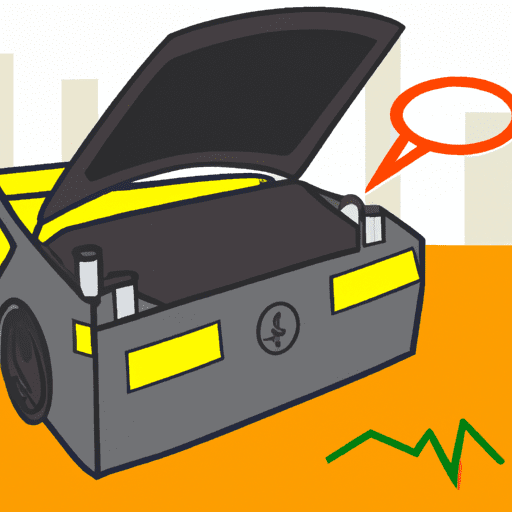
-
Table of Contents
- Introduction
- How to Diagnose a Dead Car Battery: Signs and Symptoms
- What to Do When Your Car Battery Is Dead: Tips for Jump Starting
- How to Tell If Your Car Battery Is Dead: Common Warning Signs
- How to Avoid a Dead Car Battery: Maintenance Tips and Tricks
- The Cost of Replacing a Dead Car Battery: What You Need to Know
- Conclusion
“Don’t be left in the dark – find out if your car battery is dead!”
Introduction
If you’ve ever been stranded with a dead car battery, you know how frustrating it can be. Knowing the signs of a dying battery can help you avoid being stuck in an inconvenient situation. In this article, we’ll discuss the common signs that indicate your car battery is on its last legs and what to do if you find yourself in this situation. We’ll also provide some tips on how to extend the life of your car battery and keep it running smoothly.
How to Diagnose a Dead Car Battery: Signs and Symptoms
If your car won’t start, it could be due to a dead battery. Diagnosing a dead car battery is relatively straightforward and can be done in a few simple steps. This article will provide an overview of the signs and symptoms of a dead car battery, as well as the steps you can take to diagnose and potentially fix the issue.
Signs and Symptoms
The most obvious sign of a dead car battery is that the engine won’t start. Other signs include dim headlights, slow cranking when you turn the key, and a clicking sound when you turn the key. If your car has been sitting for a while, it may also have difficulty starting due to a dead battery.
Diagnosis
To diagnose a dead car battery, you’ll need to check the voltage with a multimeter. Start by connecting the red lead of the multimeter to the positive terminal of the battery and the black lead to the negative terminal. If the voltage reads 12.6 volts or higher, then the battery is likely still good. If it reads 12.5 volts or lower, then the battery is likely dead and needs to be replaced.
You should also check the connections between the battery and the starter. Make sure they are clean and tight. If they are corroded or loose, then they should be cleaned or tightened before proceeding.
Fixing a Dead Battery
If your battery is indeed dead, then you’ll need to replace it. Make sure to use a battery that is compatible with your vehicle’s make and model. Once you’ve installed the new battery, you’ll need to charge it up before attempting to start the engine.
Conclusion
Diagnosing a dead car battery is relatively straightforward and can be done in a few simple steps. The most obvious sign of a dead car battery is that the engine won’t start, but other signs include dim headlights, slow cranking when you turn the key, and a clicking sound when you turn the key. To diagnose a dead car battery, you’ll need to check the voltage with a multimeter. If it reads 12.5 volts or lower, then the battery is likely dead and needs to be replaced. Once you’ve installed the new battery, you’ll need to charge it up before attempting to start the engine.
What to Do When Your Car Battery Is Dead: Tips for Jump Starting
If your car battery is dead, you may be able to jump start it with the help of another vehicle. Here are some tips for jump starting your car:
1. Make sure both vehicles are turned off and in park.
2. Connect the positive (red) cable to the positive terminal of the dead battery.
3. Connect the other end of the positive cable to the positive terminal of the working battery.
4. Connect the negative (black) cable to the negative terminal of the working battery.
5. Connect the other end of the negative cable to an unpainted metal surface on the car with the dead battery. This will help prevent sparks from occurring.
6. Start the working vehicle and let it run for a few minutes.
7. Try to start the car with the dead battery. If it starts, let it run for at least 15 minutes before disconnecting the cables.
8. Disconnect the cables in reverse order, starting with the negative cable first.
If your car still won’t start after following these steps, you may need to have your battery tested or replaced.
How to Tell If Your Car Battery Is Dead: Common Warning Signs
If your car battery is dead, you may experience a variety of warning signs. Common signs that your car battery is dead include:
1. Your car won’t start. If you turn the key in the ignition and nothing happens, it’s likely that your battery is dead.
2. Dim headlights. If your headlights are dim or flickering, it could be a sign that your battery is losing power.
3. Slow engine crank. If your engine takes longer than usual to start, it could be a sign that your battery is weak or dead.
4. Clicking sound when you turn the key. If you hear a clicking sound when you turn the key in the ignition, it could be a sign that your battery is dead.
5. Dashboard warning lights. If you see any dashboard warning lights related to your battery, it could be a sign that your battery is dead or dying.
If you experience any of these warning signs, it’s important to have your car battery tested as soon as possible to determine if it needs to be replaced.
How to Avoid a Dead Car Battery: Maintenance Tips and Tricks
Maintaining a healthy car battery is essential for keeping your vehicle running smoothly. A dead battery can leave you stranded and cause costly repairs. Fortunately, there are several steps you can take to avoid a dead car battery. Here are some maintenance tips and tricks to help you keep your battery in top condition.
1. Check the Battery Regularly: Inspect your battery at least once a year for signs of corrosion or damage. If you notice any issues, have it tested and replaced if necessary.
2. Keep It Clean: Dirt and debris can build up on the terminals of your battery, causing it to lose power. Make sure to clean the terminals regularly with a wire brush and baking soda solution.
3. Avoid Extreme Temperatures: Extreme temperatures can cause your battery to overheat or freeze, leading to a dead battery. Try to park your car in a shaded area during hot weather and keep it out of the cold during winter months.
4. Drive Regularly: If you don’t drive your car often, the battery may not get enough charge and eventually die. Try to take your car out for a spin at least once a week to keep the battery charged.
5. Use a Battery Charger: If you’re going to be away from your car for an extended period of time, consider investing in a battery charger. This will help keep your battery charged while you’re away.
By following these simple maintenance tips and tricks, you can help ensure that your car battery stays healthy and reliable. Taking the time to care for your battery now can save you time and money in the long run.
The Cost of Replacing a Dead Car Battery: What You Need to Know
Replacing a dead car battery can be a costly and time-consuming endeavor. Knowing what to expect in terms of cost and the steps involved in replacing a car battery can help you make an informed decision about how to proceed.
The cost of replacing a dead car battery will depend on several factors, including the type of battery you need, the labor costs associated with installation, and any additional parts or services that may be required. Generally speaking, the cost of a new car battery can range from $50 to $200, depending on the size and type of battery needed. Labor costs for installation can range from $50 to $100, depending on the complexity of the job and the shop’s labor rate. Additional parts or services may also be required, such as a new battery cable or a diagnostic test to determine the cause of the battery failure.
When replacing a dead car battery, it is important to take the necessary safety precautions. Make sure to wear protective gloves and eyewear when handling the battery, as it contains sulfuric acid that can cause serious injury if it comes into contact with skin or eyes. Additionally, be sure to disconnect the negative terminal first and reconnect it last when installing the new battery.
In addition to the cost of the new battery and labor costs for installation, there are other considerations to keep in mind when replacing a dead car battery. If your vehicle is still under warranty, you may be able to have the battery replaced at no cost. Additionally, some auto repair shops offer free battery testing services that can help you determine if your battery needs to be replaced or if another issue is causing the problem.
Replacing a dead car battery can be a costly endeavor, but understanding the costs involved and taking the necessary safety precautions can help ensure that the job is done correctly and safely.
Conclusion
In conclusion, it is important to be aware of the signs that your car battery may be dead. If you notice any of the symptoms listed above, it is best to take your car to a mechanic or auto parts store to have it tested and replaced if necessary. Taking care of your car battery can help you avoid costly repairs and keep your car running smoothly.




